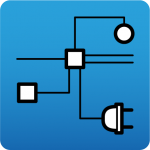Data input and output sequence for the implementation of circuit and load distribution in electrical systems
The implementation of circuit and load distribution in electrical systems can be carried out in the program by means of the following input and output sequence:
- Creating a new job (from "File", "New").
- (Optional) Linking to BIMserver.center, creating receiver types and assigning to equipment requiring power supply read from the BIM model.
- Revising and configuring general options (from "Project", "General options"), including the selection of the standard specifications and the definition of the link node types.
- (Optional) Downloading manufacturer's catalogues (from "Project", "Catalogues").
- (Optional) If not done at the time of creating the job, defining the list of available receiver types (from "Project", "Receiver types").
- (Optional) Defining the list of available grounding systems (from “Project”, “Grounding systems”) in case a grounding system is to be installed.
- (Optional) To install the lightning protection system, the protection level can be defined (from "Project", "Protection level").
- Receiver layout. The receivers are placed in the "Work area" in two ways:
- By importing them through the wizard when creating or updating the work from the loads and equipment read from the BIM project.
- By entering them freely using the "Receivers" option ("Electric loads and circuits" group).
- Panel layout. When creating the "Panels" ("Electric loads and circuits" group) of the installation, the electrical "Circuits" that feed each of the receivers are defined, in addition to the "Feeder (upstream)", whether it is another panel or a node of the feeder.
- Assigning properties to the receivers. After creating the panels and circuits, they are assigned to the receivers by editing them or using the "Assign" tool ("Electric loads and circuits" group).
- Entering conduits. When entering the "Trunking" ("Electric loads and circuits" group), users define the element to be fed, in the case of switchboards or junctions, and the "Circuits" arranged in the trunking. Then, they are drawn by connecting the different elements.
- (Optional) Entering junction boxes and switch boxes. The distribution can be detailed by entering “Junction boxes” and “Switch boxes”, which can be connected to the rest of the installation by means of “Trunking” (options in the "Electric loads and circuits" group).
- (Optional) Generation of branches and conductors. As additional tools in the "Electric loads and circuits" group, the program has several automatisms:
- “Generate branches": generates the routing of conduits between a junction box and the selected receivers.
- “Generate conductors": identifies and generates the circuits inside each trunking, and the junction boxes or nodes it feeds, depending on the distribution entered.
- (Optional) Entering the feeder. The model can be completed by entering the feeder. To do so:
- The layout of the “Link nodes” ("Electric loads and circuits" group), such as the protection boxes and the meter centralisation, is indicated.
- These elements are then connected to each other and to the switchboards using “Trunking” ("Electric loads and circuits" group).
- (Optional) Entering the elements of the grounding system in the model ("Grounding" group).
- (Optional) Entering the elements of the lightning protection system in the model ("Lightning protection" group).
- Obtaining reports and drawings (from "File", "Reports/Drawings").
- Exporting to BIMserver.center (from "BIMserver.center", "Share").

